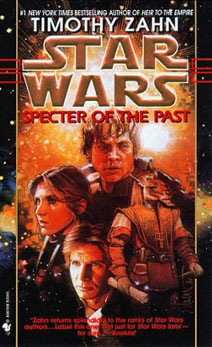Although it came out more recently than the famous Thrawn trilogy (which I reviewed in recent posts), I didn’t remember the details of “Specter of the Past” (1997) as starkly as those more-heralded books. As I suspected and confirmed on this re-reading, that’s more a matter of the Thrawn trilogy’s place in the “Star Wars” pantheon rather than any flaws with Timothy Zahn’s subsequent work. The Thrawn books re-launched “Star Wars” to the public, they were adapted into comic books, and there was nothing else released in the one-year gaps between each book, giving them more time to settle into my psyche.
Also, although the quality of Zahn’s writing is up to his usual standards, “Specter of the Past” is a more mellow, leisurely paced book. This was originally supposed to be half of one huge novel, “The Hand of Thrawn,” but when it got too massive, Zahn split it into two books, and I suspect “Vision of the Future” (1998) ratchets things up a notch.
In “Specter,” “Thrawn” is reintroduced to the galaxy, thus causing ripples in the New Republic government as intended by the scheming triumvirate — an Imperial Moff, a former Royal Guardsman and an actor. The revelation that a few Bothans played a part in the Empire’s years-ago destruction of the planet Caamas also causes political unrest. Meanwhile, Admiral Pellaeon wants to surrender to the Republic; this sets up the positioning of his character as a principled ex-Imperial in the more recent books. Thrawn’s chess-game-style schemes aren’t at play here, so we don’t get the extreme A-to-B-to-C plotting, and that’s a big reason why “Specter” breathes more.
But the two plot points I remembered most from “The Hand of Thrawn” don’t kick in until the second book: The Luke-and-Mara romance, and the introduction of Thrawn’s race, the Chiss, and how they tie in with the Empire.
The most impressive surprise on my re-reading of “Specter” is the way Zahn respectfully acknowledges events in the books that were released between 1993 and ’97. Like all “Star Wars” authors, he’s primarily concerned with his own creations — indeed, the book opens on Wayland, where the Noghri race is re-settling. However, it’s cool that he mentions events from “Shadows of the Empire,” the “Jedi Academy” trilogy, “The New Rebellion” and, most notably, the “X-Wing” novels — in fact, Booster Terrik and Corran Horn feature in this plot.
With Del Rey’s 19-book, multi-author “New Jedi Order” and nine-book “Legacy of the Force” and “Fate of the Jedi” sagas, I think of the 2000s as the decade of author collaboration, but in reality it was happening under the Bantam Spectra banner in the 1990s as well. And it wasn’t just communication between authors, but also respect for each other’s work. You’d think that another author would take Mara Jade and run with her after “The Last Command,” but actually, they mainly just left this irresistible character for Zahn.

“Specter” has another cool connection to the Thrawn trilogy. The beckon call that Luke finds in the Dagobah cave in “Heir to the Empire” was originally just a maguffin, as Zahn notes in that novel’s annotated 20th anniversary edition. But he finds a purpose for the device in “Specter” — it could lead to a copy of the Empire’s Caamas Document, which would reveal the Bothan perpetrators and settle the unrest. Zahn also links up with his own entry from “Tales from the Mos Eisley Cantina” (“Hammertong: The Tale of the ‘Tonnika Sisters'”) through the character of Shada D’ukal, a member of a secret society of spies who wants to break free and join the New Republic (as it turns out, she fits in better with Karrde, on the fringes). Unlike Mara, who was in Jabba’s Palace but isn’t actually seen in the movie, Shada can be seen in the cantina.
One oddity of “Specter of the Past” is that the pseudo-Thrawn is an actor (and we know this pretty much from the beginning, as Zahn uses a straightforward style that doesn’t forcibly hide things from his readers). Considering how much clones play into not only “Star Wars” but the Thrawn trilogy specifically, it’s interesting that he chose not to take that route here.
Most likely, he didn’t want to be redundant: For one thing, Joruus C’baoth was a clone. For another, while writing the “Hand of Thrawn” duology, he knew the prequels were on their way, presumably to flesh out the Clone Wars. Furthermore, the “Dark Empire” comic books had resurrected the Emperor around the same time Zahn invented C’baoth. (Zahn is great at referencing other novels, but not so great at referencing comic books; the cloned Emperor never comes up when the characters discuss the possibility that the new Thrawn is a clone.)
Despite the intrigue of this book’s dangling threads, the one-year wait between “Specter” and “Vision” wasn’t as tough to take as the wait between the Thrawn trilogy books. By this time, there were several novels and comics coming out annually, the original trilogy had been re-released in theaters earlier in ’97 and “Episode I” was due out in ’99. In other words, while Zahn novels are always an event, “Specter” had competition even within “Star Wars” circles.

